iPad mini Review
by Anand Lal Shimpi & Vivek Gowri on November 20, 2012 6:10 PM ESTDisplay Analysis
As with a discussion on performance in mobile devices these days, the iPad mini's display requires both an experiential analysis and an objective performance analysis. I'll begin with the experience.
Without a doubt, the iPad mini presents an evolution in form factor and nothing else. Everything from silicon to display technology are known quantities at this point. While it's true that in many senses, even Apple's previous generation mobile hardware is pretty good, the fact of the matter remains that the mini doesn't push the envelope in anything but form factor. That's not necessarily a bad thing, it's just reality. I should also point out that many smaller-versions-of-bigger-things follow this same approach of not pushing the performance envelope for obvious reasons.
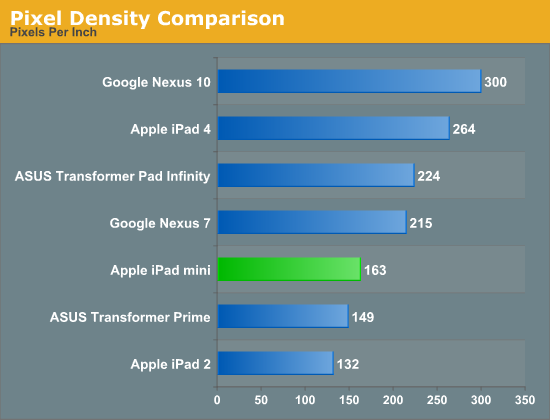
Doing the math on the mini's 1024 x 768 display results in a pixel density of 163 pixels per inch. A tangible improvement compared to the original iPad's 132 PPI, but keep in mind the smaller screen may have to be held closer to your eyes. Compared to other tablets, the mini's display resolution isn't anything to write home about. In practice, the mini's makes reading small text a problem:

While the 3rd and 4th gen iPads have a large enough display at a high enough resolution to make it possible to view the Dell configurator in the photo above without zooming, the same can't be said for the iPad mini. You're going to need a double tap.
Although reading text is one area where the absence of insane numbers of pixels is clearly obvious, it's visible in some photos as well.

iPad mini (left) vs. iPad 4 (right)
Where a lack of fine detail doesn't get you, the physical size of the display may. I was pleasantly surprised by the usefulness of Apple's 7.85-inch display, but given my early affinity towards 8-inch tablets it's not too shocking. Despite how useful the mini's display is, I found myself having to double tap to zoom in on most desktop websites just to make the reading a bit better. It's not that the process of zooming in on a website in mobile Safari is particularly cumbersome, it's that the fact that I have to makes me feel like I'm using more of an iPod Touch and less of an iPad. I do admit the feeling is quite irrational as I prefer keeping the iPod Touch (or iPhone in the case of, reality) holstered and using the mini instead. This is less a criticism of the iPad mini and more guidance for those deciding between mini and regular sizes of the iPad.
Compared to a true 7-inch tablet like the Nexus 7, the additional screen size is definitely appreciated - particularly when reading web pages:
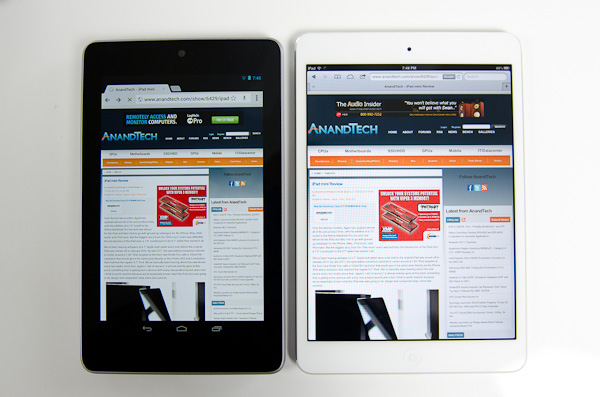
Nexus 7 (left) vs iPad mini (right)
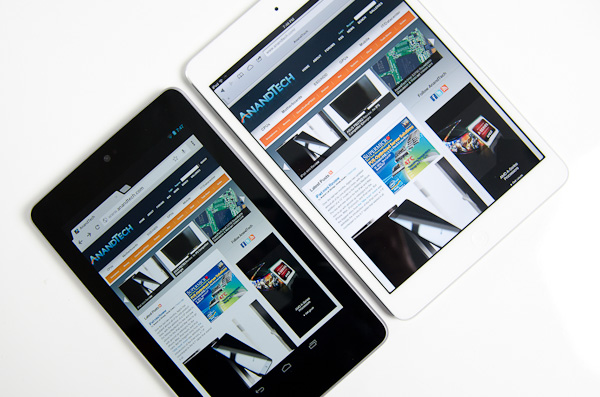
Nexus 7 (left) vs iPad mini (right)
When Vivek and I brought up the topic of the mini's lower pixel density on the Podcast, our own Brian Klug pointed out the obvious: we're spoiled. How impressed/unimpressed you are with the iPad mini's display really depends on what other displays you've been exposed to. In a vacuum, the iPad mini's display is fine. Brightness, black levels and contrast are all reasonable (and much better than most notebooks). Color reproduction isn't bad either. In the spectrum of all displays available at the mini's price point, this 7.85-inch 1024 x 768 panel isn't bad. Spend any appreciable time with the bigger iPad's Retina Display however, and your opinion will quickly change.


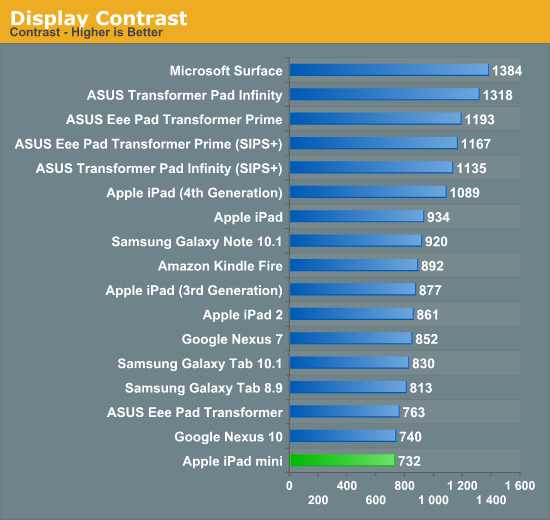
In our Surface review I titled the display section "Not Retina, But Still Good". Compared to the Surface display, the mini has better color accuracy but clearly loses out in black levels thanks to Microsoft's laminated display + cover glass stack.
To evaluate color accuracy I turned to our own Chris Heinonen's CalMAN smartphone/tablet workflow. We'll start off by looking at the calibrated white point for these tablets. What you're looking for here is a number close to 6500K:
The mini doesn't really diverge from other iPads here, although Microsoft comes closer to 6500K at 200 nits.
The next three charts look at accuracy represented as a difference between various source colors and what's reproduced on the display. The results are presented as average dE2000, with lower numbers being better.
First up is Grayscale performance, here we're looking at the accuracy of black, white and 19 shades of gray spread in between the two extremes:
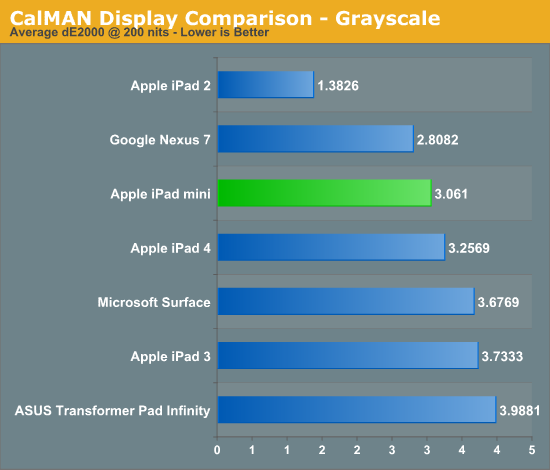
The mini does reasonably well here, it actually ends up a bit better than the 4th gen iPad. Grayscale accuracy doesn't seem to be too difficult for most folks to get right, but what happens when we start looking at colors?
First in our color accuracy tests is a saturation sweep. Here we're looking at 20%, 40%, 60%, 80% and 100% saturations of red, blue, green, magenta, yellow and cyan.
Now we start to see the retina equipped iPads pull away from the mini. Compared to the iPad 2 and even Microsoft's Surface, the mini looks pretty good, but if you compare it to the Nexus 7 or newer iPads it's clearly at a disadvantage. All of these displays are significantly better than the average notebook panel. As I mentioned earlier, it all boils down to perspective and expectations.
Gamut CIE Chart

Saturation CIE Chart

For our final accuracy test we're looking at the difference between a Gretag Macbeth colorchecker chart and the rendered swatches on these displays. Once again, lower numbers are better.
Once again, the iPad 3/4 can't be touched here, with the iPad mini falling significantly behind. Colors simply look better on the bigger iPads. The Nexus 7 does better here as well. Subjectively I found colors on the Nexus 7 to look appreciably more accurate than on the mini.
GMB Color Checker
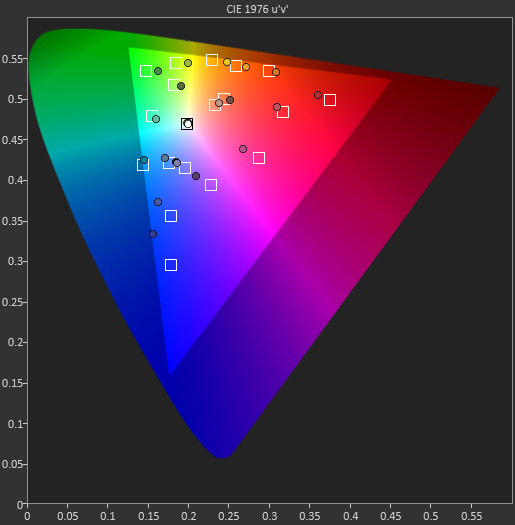
With regards to the quality and accuracy of the images rendered on the mini's screen, I feel the same way about it as I do the display on Surface: it's not a Retina display, but still good.


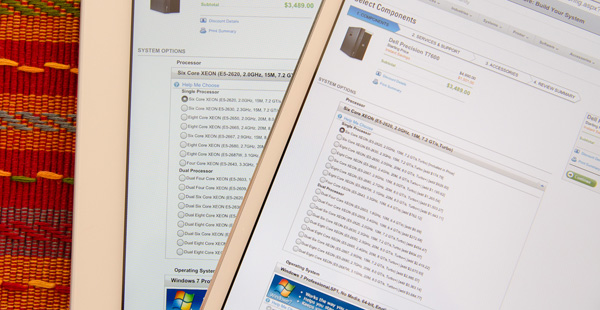
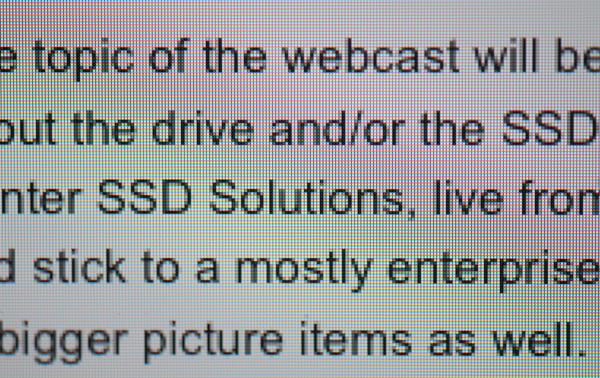
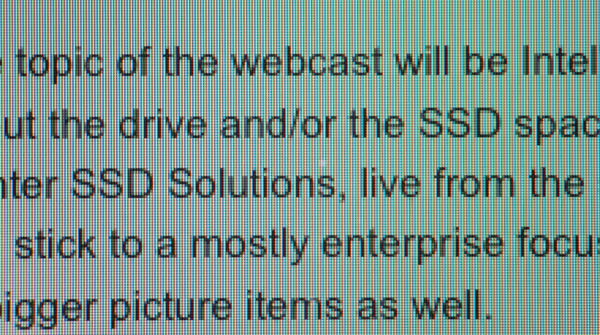
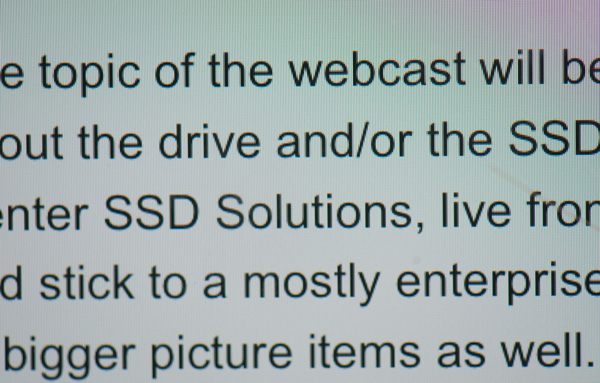
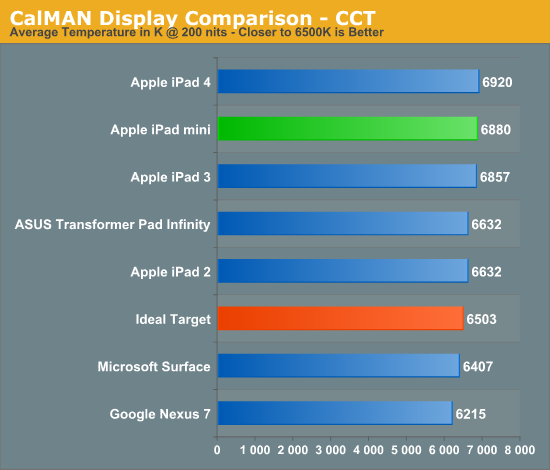
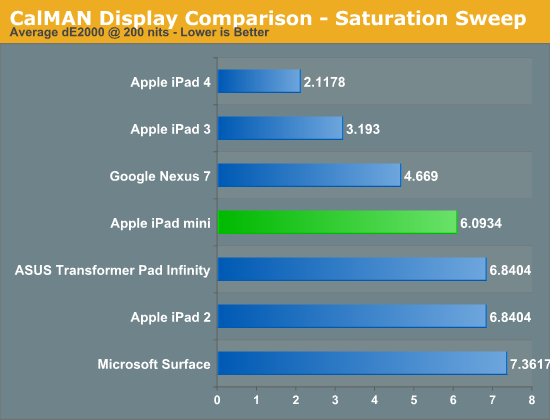
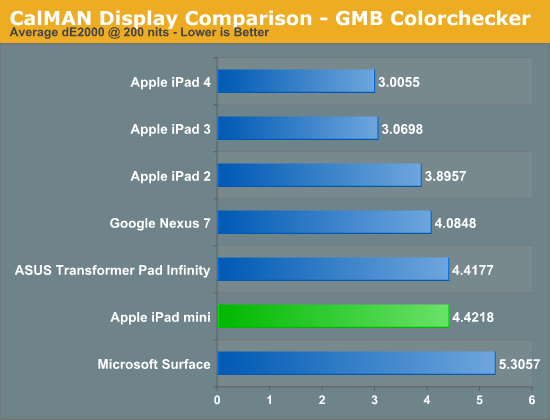








140 Comments
View All Comments
EnzoFX - Tuesday, November 20, 2012 - link
Just give the 7" the 2048 res treatment, and then double the 10" iPad's resolution once again! lol.Seriously though, it involves support on their end for some software changes, hope they follow through. I doubt they would want this mini to always (even the near future) have this resolution.
Zink - Wednesday, November 21, 2012 - link
LCDs in phones are at 440 ppi with some manufacturers testing almost 500 ppi so with a big investment from Apple, doubling the Retina (264 ppi) iPad's resolution would probably be possible within 1 or 2 years. It wont happen though because of reduced battery life and reduced performance on current hardware for a very subtle gain in image quality. It will probably be 5 years before we see 10 MP+ tablets because battery life and light weight are more important. Mobile SOCs also just aren't fast enough. Even with DDR3 next year the iPad will still only have twice the memory bandwidth it had for the iPad 3, not enough to even attempt 4x the pixels. Getting enough memory bandwidth for double Retina in an iPad will require next generation DDR technology or an even wider memory system which won't be viable anytime soon.jecastejon - Wednesday, November 21, 2012 - link
I just hope the "resolution war" on tablets and phones to be over at 400 dpi, but it should be already over at 350 dpi.From the human sight point of view it is basically over. The extra power and resources should go to better frame rates, better graphics and battery life.
Today there are a few ridiculous measurements or also detrimental technology examples going higher every day like the dynamic contrast on TVs or the megapixel war on tiny consumer sensor cameras. They are misleading advertisement.
500 dpi is useless to 99.9% of humans at almost all ages even if the technology allows to go further and further.
Dribble - Tuesday, November 20, 2012 - link
It's going to age very fast with that ancient cpu, and only 512mb of memory. Basically the moment the mini 2 comes out with a faster cpu this one will be forgotten and apps won't run on it.tbh seems like a rip off to me. It says something that the main reason I read for buying it is the shape of the screen - you've got to love that a lot to buy something that is all the other ways worse then it's much cheaper competition.
marcolorenzo - Tuesday, November 20, 2012 - link
Did you look at the benchmarks? I'm not sure I would say that it is "all the other ways worse then it's much cheaper competition."As a HTC One X user, I can tell you first hand the Tegra 3 isn't the sum of its parts, and the benchmarks that Anand provides proves that.
ltcommanderdata - Tuesday, November 20, 2012 - link
You actually anticipate developers will drop support for the iPad Mini "the moment" the 2nd generation is released? The 1GHz A5/A5X CPU is also used in the iPad 2 and iPad 3, while the slower 800Mhz A5 is used in the iPhone 4S and 5th gen iPod Touch which will both be on sale into 2014 given Apple's 3 year iPhone and 2 year iPod Touch sale cycles as they move down price tiers. The majority of iOS devices are A5 devices and will be for the next year or 2. The vast majority of apps still support 3rd generation devices and 4th generation device support is even higher. Apple's license agreement guarantees the iPad Mini will get iOS 7 and historically each device runs 3 major OS revisions over it's lifespan, so the iPad Mini will likely get OS updates into 2015. The chances of developers dropping support for 5th generation devices like the iPad Mini in the next year or 2 seem slim.Dribble - Wednesday, November 21, 2012 - link
You can think that if you like but 512mb of ram is already a limiting factor, and the cpu/gpu will start to be come one too as time goes by.This is the world of apple - if it's not new then it doesn't matter, and with the mini you are essentially buying something that's already 1 1/2 years old.
drx11 - Sunday, November 25, 2012 - link
Except its 512MB (megabytes, no mb or megabits) of RAM.... but I know what you are saying. I suppose you should have some concern, but then again Apple - at least for the last few years - has been the best at SoC and even my old arsed iPhone 3GS runs well with iOS 5. It could run iOS 6, though it wont have the best features ... so that should change your mind.Unlike Google/OEMs/phone carriers, Apple supports its hardware and you get more out of the hardware - even when the specs are not "as good" as the competition.
DeciusStrabo - Thursday, November 22, 2012 - link
CPU is still ok, GPU the same, but the 512 MB RAM is absolutely something that's a worry. It wasn't enough on my iPad 2 a year ago and it's very annoying in Safari if you have several tabs. And it will only get worse as time moves on. Adding another 512 MB RAM would have cost Apple basically nothing and made the product a lot more future proof (as far as it is possible in this fast-moving segment of a fast-moving industry).karasaj - Tuesday, November 20, 2012 - link
Will it blend?